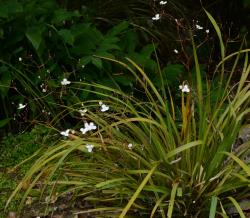- Taxon
- Gallery
Plants consisting of leafy fans, closely bunched on short, much branched rhizomes. leaves broad, flaccid, tips usually lying on ground, (500)- 700-960 × (7)-10-14 mm, green to yellow-green, slightly falcate, the 2 sides similar; leaf bases green to red-brown; veins numerous, median ones may be crowded to form a slight midrib; margins coarsely scabrid; leaf in transverse section a flattened convex lens shape, 2 rows of vascular bundles present centrally, with a single row of vascular bundles in more than half of the leaf width, marginal vascular bundle present, sclerenchyma present on inside of leaf sheath. Inflorescences long (400-720 mm), often shorter than leaf tips at anthesis, but elongating during fruit development to reach at least 2/3 the length of the leaves; peduncles 1/5-2/5 the length of the inflorescence. Panicle broad, usually openly branched; lower bracts long (40-100 mm), green and lanceolate, upper bracts shorter (15-40 mm) and green-brown, occurring singly; 1—7 flowers per branch. Pedicels slender and delicate, glabrous, 10-20 mm long. Perianth bud often pigmented externally, usually longer than ovary at anthesis. Flowers 12-15 mm diam.; tepals all white internally, inner tepals orbicular, unguiculate, usually overlapping outer tepals, cleft present at tips; outer tepals <1/2 length of inner tepals but < 1/3 the area, narrower, elliptical, red-brown, boat-shaped, with apiculus of fine hairs. Staminal filaments very shortly connate; anthers 1-2 mm long, yellow; pollen sacs broad, connective narrow; pollen ellipsoidal, monosulcate, 37.5-45.0 × 27.5-32.5 μm. Ovary dark green, 1/2 the length of perianth bud; style branches not winged, usually pointing upwards. capsule 6-18 mm long, 4-9 mm diam., tear-drop shaped, ripening from green to yellow or black, usually fully dehiscing by loculicidal openings. Seeds 1.0 × 1.0-1.5 mm, rounded, with reticulate-foveolate surface patterning, yellow to yellow-orange.
[Reproduced from Blanchon & Weaver (2009, New Zealand J. Bot. 47: 317–324) with permission from The Royal Society of New Zealand.]




